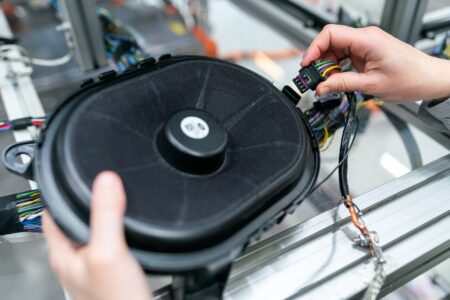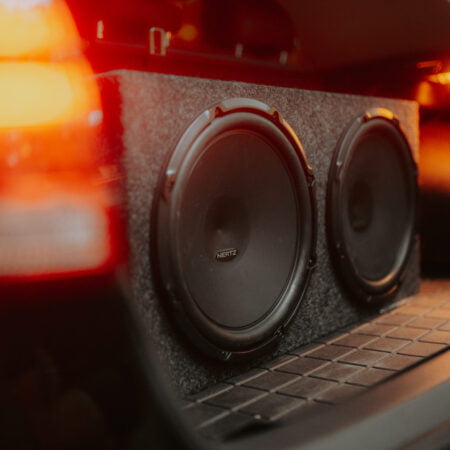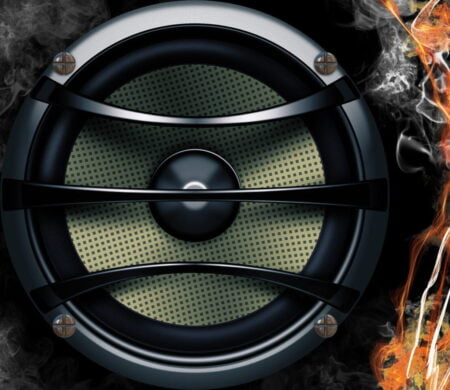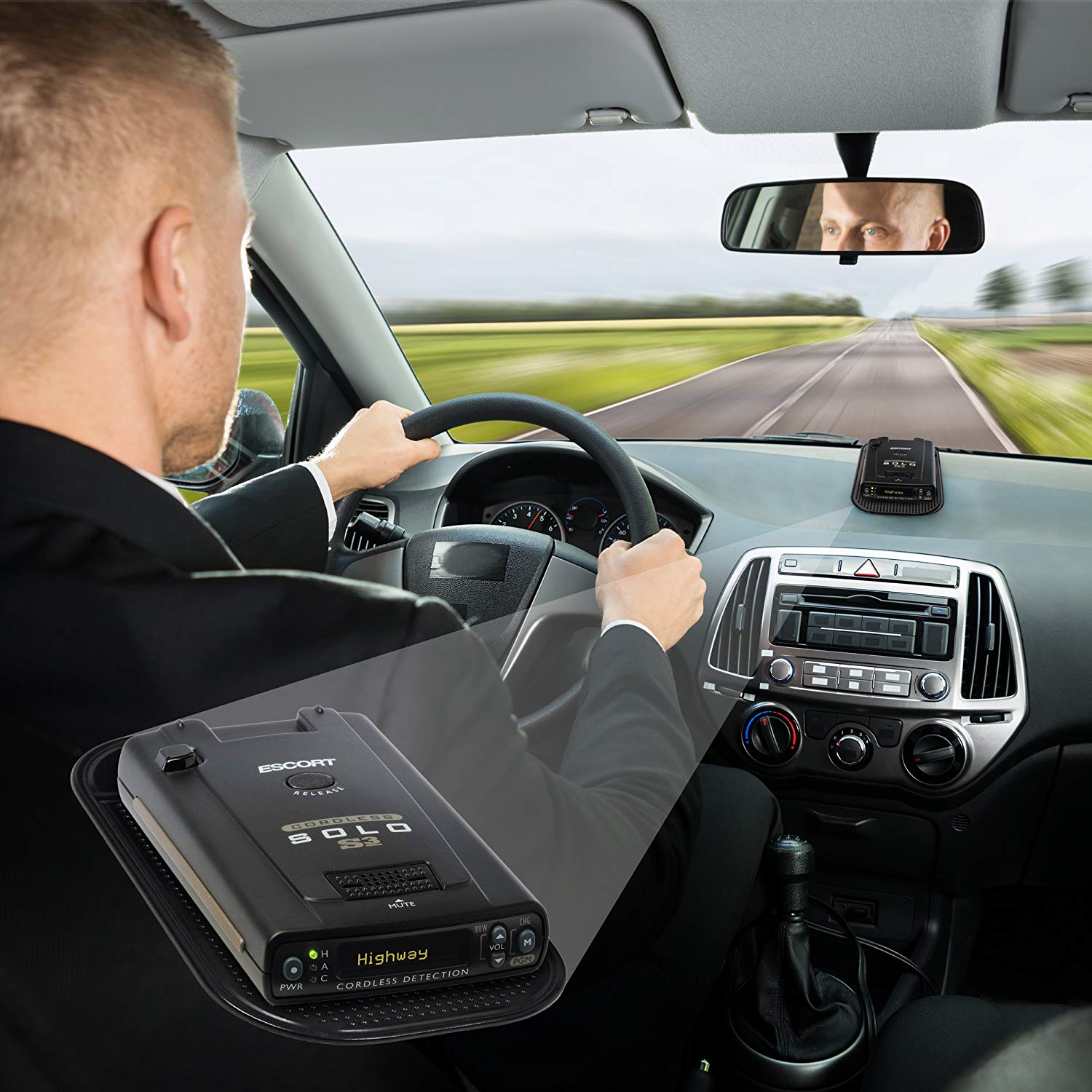Table of Contents
- 1 Top 3 Recommended Best Car Speakers
- 2 Why Choose the Best Car Speakers?
- 3 How to Choose the Best Car Speakers
- 3.1 Understanding Car Speakers
- 3.2 Type of Car Speakers Depending on the Location of Installation
- 3.3 Size and Compatibility of the Best Car Speakers
- 3.4 Sensitivity and Power-Handling
- 3.5 Design of Car Speakers
- 3.6 Build Quality
- 3.7 Speaker Brands
- 3.8 Setting Your Budget
- 3.9 Installation
- 3.10 Support and warranty
- 3.11 Conclusion
- 4 Best Car Speakers: Recommendations
How do you choose the best car speakers in 2025? What properties and features should the best car speakers have to suit your needs? Read our guide and make an informed choice.
 Having a quality sound system in your motor can be the cherry atop the road-trip cake, an added layer of enjoyment to the driving experience.
Having a quality sound system in your motor can be the cherry atop the road-trip cake, an added layer of enjoyment to the driving experience.
You might be an audiophile or merely someone who wants a decent quality system for your daily commute; either way, choosing the best car speakers can be a daunting task.
Today, we’ll break it down for you, simplifying your selection process so you can make an informed decision.
Top 3 Recommended Best Car Speakers
Why Choose the Best Car Speakers?
Unless you bought a new car with a premium audio system, it has cheap car speakers system installed in the factory – usually with a single speaker that reproduces all the frequencies of the audio signal.
Car makers use low-quality car speakers to keep manufacturing costs as low as possible. However, factory-installed car speakers can quickly lose their fidelity, especially if you always use the audio system.
 After a while, your favourite songs will start to sound tired and distorted, forcing you to listen at low volume or to stop the audio system.
After a while, your favourite songs will start to sound tired and distorted, forcing you to listen at low volume or to stop the audio system.
Fortunately, replacing car speakers equipped from the factory with some better products is pretty easy, the only tool you’ll need is a screwdriver.
Replacing the simple car speakers from the factory with some quality speakers equipped with multiple audio channels will provide a significant improvement in the sound quality in your car.
Two or three-way car speakers are the most popular choices when it comes to replacing those in the factory because separate speakers faithfully play different audio frequency ranges. Instead of a single loudspeaker to handle all frequencies, mixing bass, mediums and highs without any success, they will be heard clearly and bright.
The best car speakers will allow you to discover sounds you did not hear using the speakers that came with the car. You will even understand the lyrics that before seemed unintelligible and the fine guitar accords that were buried in the noise. You will hear the drums as if you are at a concert.
By replacing the car speakers from the factory, the daily journey to work will become a joy that you can hardly expect. You will be anxious to start your journey long enough to enjoy the quality of music for a long time and you will not find it so much a chore to travel a road that crosses the city.
The best car speakers will help you rediscover your passion for music!
How to Choose the Best Car Speakers
The speakers create the sound by moving the air in their neighbourhood on different frequencies.
This basic property makes cars one of the toughest acoustic spaces because there are a multitude of factors that can influence air movement: sound of engine vibrations, sound and vibration of the tires while running on the road, the capabilities of the inside materials to reflect or absorb the sound waves, the shape of the interior, etc.
Every car presents its own acoustic challenges. A car speaker can sound perfectly in a car model and very stupid in another.
The first step in choosing the right car speakers is finding the right size for your car. It does not matter how well a speaker sounds if it does not fit in the grip.
The usual places where speakers are mounted are the doors of the car and the rear axle, above the luggage compartment.
Below are some basic criteria for guiding you when choosing the best car speakers.
Understanding Car Speakers
Car speakers come in two primary types: full-range (coaxial) speakers and component speakers.
Full-Range Speakers
Full-range speakers contain all the speaker elements in one unit: the woofer for the lows and the tweeter mounted onto the woofer to produce high frequencies.
Some models also have additional drivers, like midrange or super tweeter. These speakers are an ideal choice if you’re looking for a quick, easy, and usually inexpensive replacement of your factory-installed speakers.
Component Speakers
Component systems, on the other hand, feature separate woofers, tweeters, and sometimes mid-range speakers. Such a design allows for greater depth and detail in the sound because each component is designed to produce its specific range of frequencies optimally.
It also offers better imaging with the flexibility to place your tweeters closer to ear level.
Type of Car Speakers Depending on the Location of Installation
Rear Speakers
For the rear-mounted speakers you need to be careful not only to their ability to reproduce a bass but also to the faithful reproduction of the other frequencies as well as to the stereo space effect that must leave the impression that the whole band is with you in the car .
 One of the most important specifications of a car speaker is the sensitivity that is measured by the volume you hear standing one meter away from the loudspeaker when the loudspeaker uses 1 Watt of power.
One of the most important specifications of a car speaker is the sensitivity that is measured by the volume you hear standing one meter away from the loudspeaker when the loudspeaker uses 1 Watt of power.
A higher sensitivity score means you can produce more volume with less power. In addition, consider the frequency response, maximum power, impedance and mounting depth.
Door speakers
Door speakers differ quite a bit in size. For example, a small car will use 8-10 centimetres speakers due to limited space. Most mid-sized cars use 13-centimeters in diameter for door-mounted speakers. However, the most common dimension is 16.5 centimetres.
Consider the same sound reproduction criteria as the rear speakers, comparing sensitivity, frequency response, maximum power, impedance and mounting depth.
The best door car speakers have high sensitivity and power, low impedance and low installation depth.
Size and Compatibility of the Best Car Speakers
One of the most critical aspects when choosing your car speakers is size and compatibility. As cars come in all shapes and sizes, so too do their in-built speakers.
 To ensure a smooth installation process and a well-integrated sound, you need to pick speakers that will fit your vehicle’s current setup. Let’s take a closer look at this.
To ensure a smooth installation process and a well-integrated sound, you need to pick speakers that will fit your vehicle’s current setup. Let’s take a closer look at this.
Identifying Your Car’s Speaker Size
Before anything else, you need to know what size your existing speakers are. Speaker sizes can range from smaller 3.5-inch speakers, often found in dash applications, to larger 6×9-inch speakers typically seen in rear deck installations. The most common size for door speakers is usually 6.5 inches, although some vehicles may use 5.25-inch or 6×8-inch speakers.
To identify your car’s speaker size, you can refer to your car’s manual, look at the manufacturer’s website, or even remove the speaker and measure it. However, the easiest way is usually to use an online vehicle-fit guide. Many car audio retailers provide these fit guides on their websites, where you enter your vehicle’s make, model, and year, and the guide will tell you what size speakers you can install.
Considering Depth and Shape
However, size isn’t the only thing to consider when looking at compatibility. The depth and shape of your speaker housing are also critical factors.
Some speakers are deeper than others due to larger magnets or other design elements, and if the new speaker is too deep, it may not fit into the existing space in your car’s door or dashboard.
Similarly, the shape of the speaker can impact compatibility. For instance, a round speaker won’t fit into an oval-shaped hole. Even among speakers of the same general shape, the screw holes may not align properly, requiring additional drilling or mounting brackets.
Speaker Impedance
Another critical compatibility factor is the speaker’s impedance, measured in ohms. Most car speakers are 4 ohms, but 2-ohm and 8-ohm speakers are also available.
Your new speakers should have the same impedance as the original speakers to match your car’s audio system’s power output. Using speakers with a different impedance can result in poor performance or even damage your audio system.
Sound Signature and Overall Experience
Finally, it’s worth considering how the speakers’ sound signature will integrate with the rest of your audio system.
 If you’re replacing all your speakers at once, this isn’t as much of a concern, but if you’re only replacing one pair, you’ll want to choose speakers with a similar sound signature to your existing speakers to ensure a consistent, balanced sound throughout your vehicle.
If you’re replacing all your speakers at once, this isn’t as much of a concern, but if you’re only replacing one pair, you’ll want to choose speakers with a similar sound signature to your existing speakers to ensure a consistent, balanced sound throughout your vehicle.
In summary, understanding your car’s speaker size, housing dimensions, impedance, and sound signature is crucial for choosing speakers that will fit and work correctly in your vehicle.
By doing so, you’ll be on your way to enhancing your on-the-road audio experience.
Sensitivity and Power-Handling
Two key specifications that you should pay close attention to when selecting your car speakers are sensitivity and power-handling.
These terms might seem a bit technical, but don’t worry; we’ll demystify them for you, explaining why they’re crucial in finding your perfect speakers.
Sensitivity
The sensitivity of a speaker refers to the amount of sound that a speaker yields from the power supplied to it. Measured in decibels (dB), this spec signifies how loud your speakers will play per watt of power at a given distance.
Speakers with high sensitivity ratings (usually over 90 dB) are especially efficient at converting power (watts) into sound (volume).
If your car stereo is a low-powered unit, such as most factory-installed systems, you’ll get more bang for your buck by choosing high sensitivity speakers. They’ll make the most out of the limited power they receive.
On the flip side, if you have a high-powered system (an aftermarket stereo or external amplifiers), speakers with lower sensitivity ratings can handle the higher power levels and will deliver a more precise, clear sound.
Power-Handling
Power-handling refers to the level of power (measured in watts) that a speaker can manage. If you are working with a low-powered system, your speakers don’t necessarily need a high power-handling capacity.
However, if your system includes powerful external amps, you should aim for speakers that can handle the output power of your amps.
Two numbers often given for power-handling are “peak power” and “RMS power.”
Peak power is the maximum power level that the speaker can handle in short bursts. However, the RMS (Root Mean Square) power is arguably the more critical figure. It refers to the amount of continuous power that a speaker can handle without suffering damage or distortion. Always match the RMS rating of your speakers to the RMS output of your amplifier for optimal performance.
 Moreover, ensure that the speakers’ impedance (measured in ohms) matches that of your amplifier. Most car speakers and amplifiers are designed to work at 4 ohms, but 2-ohm and 8-ohm models are also available.
Moreover, ensure that the speakers’ impedance (measured in ohms) matches that of your amplifier. Most car speakers and amplifiers are designed to work at 4 ohms, but 2-ohm and 8-ohm models are also available.
A mismatch in impedance can lead to poor performance or potential damage to your speakers or amplifier.
Understanding both the sensitivity and power-handling capacity of your speakers is critical to creating an audio system that works harmoniously and delivers the sound quality you desire.
High sensitivity and appropriate power-handling not only protect your speakers from potential damage but also ensure that your system can deliver clear, distortion-free sound at the volume levels you prefer.
Remember, the ultimate goal is to create an audio experience that is enjoyable to you. Sensitivity and power-handling are two tools to help you achieve that outcome.
With the right knowledge and a bit of careful shopping, you’ll soon have a sound system that hits all the right notes.
Design of Car Speakers
We find a wide range of models in the car speaker series. If you want the best audio experience you will have to choose specialized speakers. However, these speakers are not for the novice of car audio systems.
Using a subwoofer and tweeters as separate speakers requires a personalized installation, and you will definitely need to dismantle the entire interior of the car to find the ideal mounting position for them.
If you are an audiophile that can not live without the best audio experience, it’s definitely worth the trouble.
The most common models of car speakers are those with two or three ways. These speakers incorporate a bass speaker and additional speakers for medium and high frequencies.
Some manufacturers even offer four or five-way loudspeakers that further lead the separation of frequencies.
The best car speakers include a tweeter with adjustable position that allows you to position the sound in the best position for your car.
Build Quality
The durability and overall performance of your speakers depend on the material used. Woofers made from stiff yet lightweight materials, such as polypropylene mixed with mica or metal-coated synthetic fabrics, deliver satisfactory bass response.
 For the tweeter, materials like silk, textile blends, or ceramic can provide a more refined, mellow sound, while metal, graphite, or plastic tweeters produce a poppier, brighter sound.
For the tweeter, materials like silk, textile blends, or ceramic can provide a more refined, mellow sound, while metal, graphite, or plastic tweeters produce a poppier, brighter sound.
Speaker Brands
When it comes to brands, it’s generally safe to say you get what you pay for. Pioneer, Alpine, JBL, Kenwood, and Kicker have been in the audio game for a long time and have a reputation for quality.
It’s essential to read reviews and check for warranty information to ensure you’re getting a reliable product.
Setting Your Budget
Car speakers can cost as little as £25 for a pair of low-end coaxials or up to several hundred for a high-end component system. Identify what you’re willing to spend before you start shopping around. Remember, quality matters, and as with most things, you’ll often find that spending a little more initially can save you a lot of hassle and expense in the future. Additionally, bear in mind the potential costs of any necessary extras like speaker adapters, wiring, sound deadening materials, or professional installation.
Installation
Once you’ve made your choice, consider the installation process. Installing new speakers can range from relatively straightforward to complex, depending on your vehicle and the type of speakers. You might feel comfortable doing it yourself, especially if it’s a simple direct replacement.
However, for component speakers, which may require additional holes or mounting tweeters in a new location, you might want to consider professional installation to ensure the job is done right.
Support and warranty
First of all, you should consider the manufacturer’s warranty. For most models this is one year. In case you have problems with the purchased product, choose a manufacturer that offers phone or email support and has an authorized service centre in your area. You can also find solutions and answers to questions on forums for users passionate about car audio.
If the car speakers you hear sound broken and tired, you have no reason not to replace them with much better car speakers. In most cases, installation takes just a few minutes. A screwdriver and a desire to experience high-quality sound are all you need.
Conclusion
In summary, choosing the best car speakers depends on understanding your needs and preferences, the compatibility and power of your current system, and your budget.
Keep in mind that while specs, reviews, and recommendations are helpful, your ears are the ultimate judge. After all, you’re the one who’s going to be enjoying those high-quality tunes on the road.
To get the best experience, invest in quality speakers from reputable brands, and don’t forget to consider the installation process and costs.
High-quality car speakers can transform your everyday drive into an extraordinary journey, making every trip a pleasure, whether you’re off on a grand adventure or just popping to the shops.
Happy listening!
Best Car Speakers: Recommendations
Taking into account the above criteria and user recommendations, you will find below some models of car speakers that offer excellent quality / price ratio.
- 🔊 300 WATT POWER: Pyle offers a pair of car speakers with 150W RMS to 300W peak power and 4-ohm impedance, delivering high-quality sound at loud volumes with style.
- 🎶 16.5 CM SPEAKERS: 16.5 cm x 16.5 cm x 5.4 cm black poly injection cone. Boosts car stereo with powerful audio. Includes 570g high-density rubber magnet boot.
- 🎵 2 CM PIEZO TWEETERS: 2 cm piezo tweeters and 2.54 cm neodymium midrange with butyl rubber surround for durability and clear sound.
- 280 Watts Max (40 Watts Minimal)
- IMPP Composite Cone
- Supplied as a pair and with grills
- 230 Watts Max (35 Watts Minimal)
- Diameter 130
- Supplied as a pair and with grills
- Maximum Music power: 210 W; Sound pressure: 87 dB
- The new, improved G-Series speakers are specially designed for first-class and powerful sound and offer excellent value for money
- Its robust, lightweight construction with even more mounting options makes it very easy to install in a large number of vehicle models
- Active / Passive Speakers: Passive
- Active/passive: Passive
- Built In/External: External Passive
- 360 MAXIMUM WATTAGE FOR SUPERIOR SOUND: Upgrade your vehicle's audio system with powerful 360-watt peak performance. Enjoy deeper mid-bass and long-lasting durability with high-quality butyl rubber surrounds.
- VERSATILE MOUNTING OPTIONS: Mount your speakers easily with included hardware for both flush or surface mounting. The 5.9 cm mounting depth gives you flexibility to fit them in various locations.
- CRYSTAL CLEAR SOUND WITH MINIMAL DISTORTION: Non-fatiguing butyl rubber surrounds and a 2.5 cm high-temperature ASV voice coil ensure pristine sound quality even at peak wattage—no distortion, just pure audio.
- Car Speaker
- 3-way
- Dimensions 178 mm x 74 mm
- 3-way
- Car Speaker
- Diameter 100
Last update on 2025-11-05 / Affiliate links / Images from Amazon Product Advertising API
This product presentation was made with AAWP plugin.





